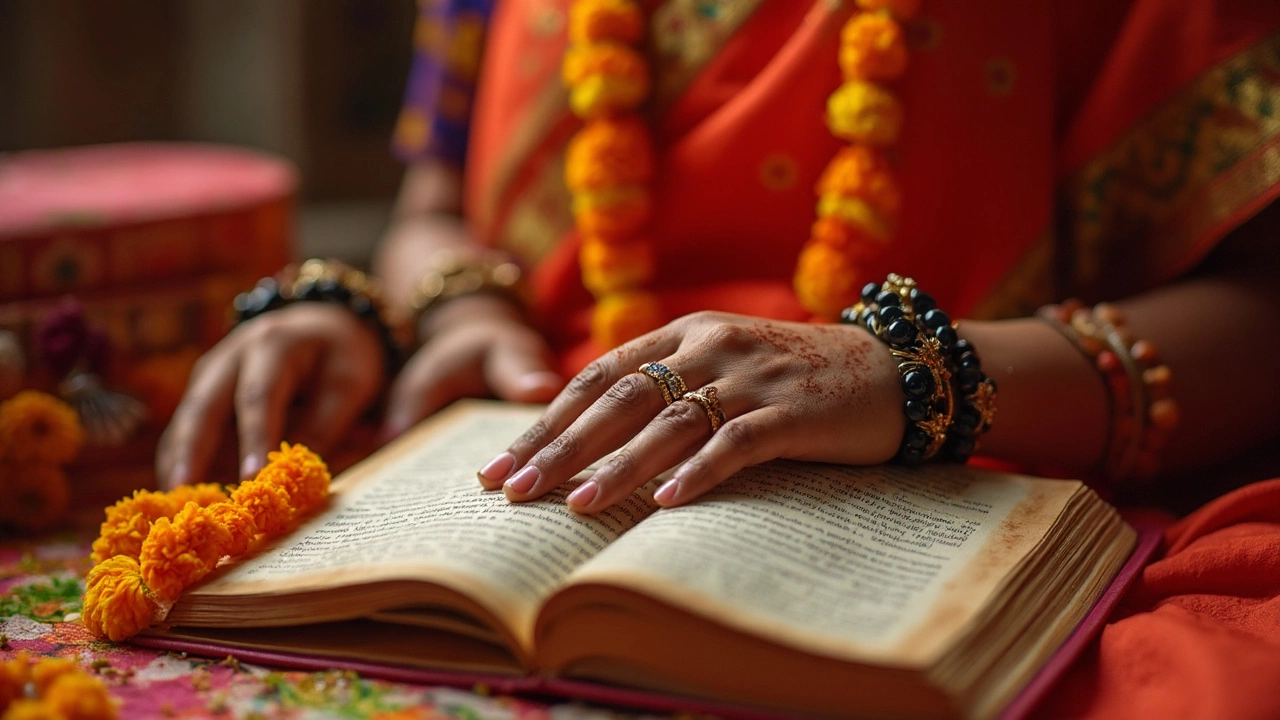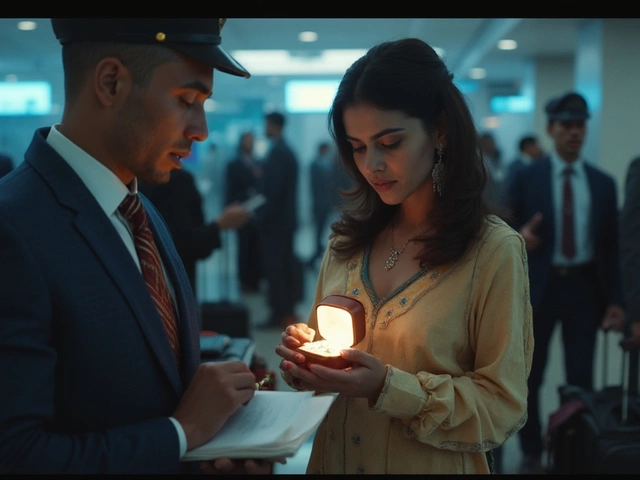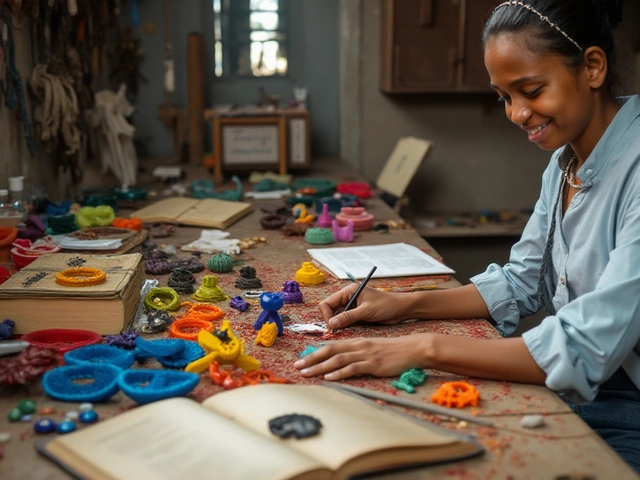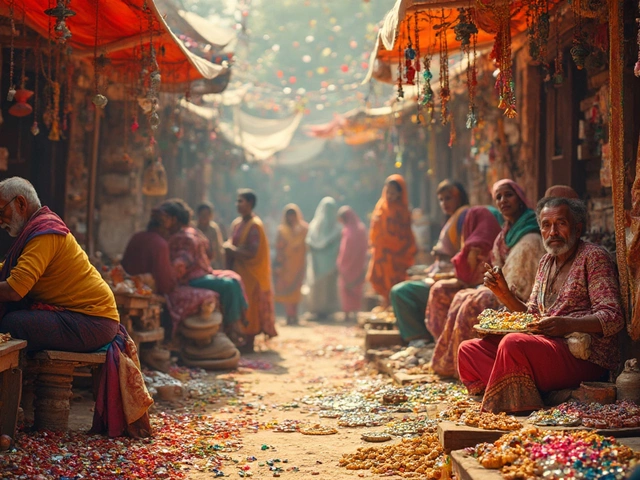
Ever wondered why you spot black bangles on wrists all over India, from busy metro crowds to small-town gatherings? There’s more to them than just matching an outfit. Black bangles carry stories, superstitions, and even silent wishes for well-being.
People believe that black wards off the bad stuff—think evil eye, jealousy, or random bad luck. That’s why you’ll often see black threads or tiny black bangles on babies, used by parents who want to keep their children safe. It’s like a daily, wearable good luck charm.
But black bangles aren’t just for keeping negativity at bay. For many women, especially in places like Maharashtra and Andhra Pradesh, they tie into ideas of marital status or special milestones. Sometimes, they show respect for tradition or community rules. And honestly, sometimes they’re just chosen because they look wicked cool with both ethnic and Western outfits.
- Why Black Bangles Stand Out
- The Protective Power of Black
- Cultural Meanings Across India
- When and Who Wears Black Bangles
- Black Bangles in Modern Fashion
- How to Choose and Style Black Bangles
Why Black Bangles Stand Out
There’s something about black bangles that just catches the eye, whether you’re at a festive family function or waiting for chai at a street stall. Unlike the reds and greens that flood most traditional sets, black cuts through as bold and even a little rebellious. People notice, and that’s part of the charm.
The real reason these bangles pop is their mix of tradition and attitude. Black isn’t a color you’ll see everywhere in Indian jewelry, so it almost always means something. Growing up, you probably saw babies with thin black bangles. That’s not just for looks—parents believe they fend off the evil eye. According to a survey by the Indian Journal of Traditional Knowledge in 2020, about 68% of urban families still use black bangles or threads as protection for their kids.
But it’s not just for kids. Adults use them for a sort of fashion-meets-superstition reason. You might spot someone at a wedding or a temple visit sporting a sleek set of black bangles; sometimes it’s a way to avoid drawing ‘bad’ attention. Other times, it’s about standing out in a crowd of glass and gold.
- Black bangles often go with both traditional and modern clothes.
- They’re easier to style because they don’t clash with bold prints or bright colors.
- Some communities use black bangle sets for mourning or remembrance, giving them a deeper emotional value.
| Reason | Black Bangles Used? | Who Wears Them? |
|---|---|---|
| Protection from evil eye | Yes | Babies, women, men |
| Statement fashion | Yes | Teens, young adults, influencers |
| Cultural rituals | Varies | Women (married or unmarried) |
| Mourning | Sometimes | Specific communities |
All this makes the black bangles more than just regular jewelry. They’re a blend of meaning, function, and straight-up style—something that just feels different when you wear it.
The Protective Power of Black
Let’s cut to the chase—across India, black isn’t just a color. For ages, people have seen it as a shield. This idea goes way back, and it’s not just about superstition. Parents slip black bangles or threads on babies right after birth. It’s their go-to way to block out what everyone calls the “evil eye” or ‘nazar.’
The thinking is pretty simple: black absorbs negativity, keeping it from touching you. Walk around a local market, and you’ll spot these tiny black bangles on infants and kids everywhere. It would be hard to find a region where this isn’t a thing. Sometimes, grown-ups wear them after recovering from an illness, as a way to protect their health or just feel a little safer.
You’ll also find black bangles being mixed in with other colors—especially in glass bangle sets worn by married women. The black bangle in the set acts as a guard, breaking if any bad energy comes close. Lots of folks swear by this even today.
- Parents trust black bangles for babies as a layer of protection.
- Many believe black bangles prevent jealousy or negative intentions from others.
- Mixing a black bangle with colored ones is thought to ‘catch’ bad vibes.
And here’s something interesting: A 2023 survey in Mumbai found that over 70% of mothers used black threads or bangles on their kids for protection, even if they lived in big cities and didn’t follow other traditional habits. That tells you it’s not just an old myth—it’s alive even in modern life.
| Use | Common Age Group | Main Purpose |
|---|---|---|
| Infants & Toddlers | 0-5 years | Warding off the evil eye |
| Adults | 18+ years | Protection during illness or tough times |
| Married Women | 20+ years | Safety and tradition |
So, next time you see someone wearing a black bangle, remember: for a lot of people, it’s like armor—one you don’t see, but they swear by it all the same.
Cultural Meanings Across India
Black bangles aren’t just a trend—they’ve got roots deep in a bunch of Indian cultures. What they symbolize actually shifts depending on where you are in India. In states like Maharashtra, it’s common to see married women sporting black bangles along with green glass ones. These black bangles are believed to keep negative energy at bay while marking new beginnings, especially for newly married women.
Hop over to South India, especially places like Andhra Pradesh and Telangana, and you’ll notice babies and young children often wear thin black bangles or black threads on their wrists and ankles. Parents put them on kids to guard against the evil eye—sort of like a daily shield. Families often continue this ritual for years because it’s just a part of daily life and tradition.
In some communities, black bangles can signal mourning or remembrance, but that’s not a universal thing. For most, though, the focus is more on protection and symbolism than sadness. For example, among some Gujarati and Rajasthani groups, black beads or bangles get mixed in with colorful ones to balance out one’s spiritual energy.
Religious meanings pop up too. You’ll see black bangles handed out at temples during religious festivals, especially at shrines dedicated to deities like Kali or Shani, who are tied to the color black. Wearing these after a visit is thought to bring blessings and shield from obstacles.
So, it’s clear: black bangles mean different things, but they always have a purpose. Whether it’s about keeping negativity away, showing off marital status, or simply passing down traditions, these bangles stick around because they fit into everyday life in real, practical ways.

When and Who Wears Black Bangles
Black bangles pop up everywhere in India, but who actually wears them—and when? Let’s get right to it. For starters, it’s super common to see black bangles on babies and toddlers. Many Indian families believe the color black keeps the evil eye away and shields little ones from bad vibes. Sometimes, parents combine black glass bangles with black threads or beads on a child’s wrist or ankle, especially after a baby’s first public outings.
If you travel through Maharashtra, you’ll spot women—especially married ones—pairing green glass bangles with black ones. Black bangles here aren’t random; they show respect for local customs and mark marital status. In Andhra Pradesh, newlyweds often receive black bangles as part of the wedding gifts, a tradition tied to wishes for happiness and protection.
It’s not just about marriage and babies, though. Some younger women, and sometimes even men, wear black bangles as a style statement or to feel connected to tradition. For those who believe in astrology, black bangles are sometimes recommended on Saturdays to please Shani (Saturn), believed to bring stability or ward off tough luck.
- Babies and toddlers usually wear black bangles for protection against negativity.
- Women in places like Maharashtra and Andhra Pradesh use black bangles to show marriage and stick to tradition.
- Fashion and astrology sometimes get people to try black bangles too, especially on special days like Saturdays.
So, while anyone can wear black bangles, the reason behind them can change a lot—protection, tradition, fashion, or all the above. If you’re thinking of wearing them, just know you’re carrying a slice of Indian culture on your wrist, whether it’s for old-school reasons or just personal style. The black bangles still carry their old-school meaning, even if they look super modern.
Black Bangles in Modern Fashion
Black bangles have totally broken out of their old-school roles. Now, you’ll see them everywhere, mixing with jeans and crop tops just as much as with sarees or lehengas. A lot of it comes down to flexibility—they look sharp with pretty much anything, and they can swing from casual to fancy. Pop stars and Bollywood celebs like Deepika Padukone and Alia Bhatt have been spotted sporting these, giving them a stamp of glam.
If you're after that minimal, "throw on and go" vibe, black bangles nail it. Many brands, even top ones like Tanishq or Amrapali, sell sleek black glass, metal, and enamel bangles in tiny sets or chunky singles. Go search their sites and you’ll see some cool, bite-sized collections.
What’s cool is how people stack them—layer a few black ones with gold or colored bangles for a new twist. Guys do this too, pairing black bangles or bead bracelets with watches or casual wear. It's all about mixing textures and stacking layers for a look no one else has. Here's an idea—it’s way more about personal expression now than just tradition.
For those who love numbers, sales of black bangles in India have jumped by about 27% in online markets between 2021 and 2024, according to a Myntra trend report. That’s a big leap considering all the jewelry choices out there.
| Brand | Popular Black Bangle Styles | Average Price (INR) |
|---|---|---|
| Tanishq | Black enamel gold bangle | 3,500-25,000 |
| Amrapali | Oxidized black stone bangle | 1,500-8,000 |
| Tribe by Amrapali | Minimalist resin bangle | 400-2,000 |
If you’re picking a set for yourself, try matching the black bangle with your watch, a leather strap, or a mix of silver and colored bangles. There’s no "must" or "should" here—just pick up a few and see what feels right. Sometimes, the best stack is the one you make up as you go.
How to Choose and Style Black Bangles
Shopping for black bangles is more than picking something that fits. First, look at the material. Glass bangles are classic and carry a strong traditional vibe, but can break easily. Metal options—like oxidized silver or gold-plated brass—are sturdy if you want something for daily wear or you’re a bit clumsy (we’ve all been there). Plastic or resin versions are super affordable and lightweight, great for teens or anyone looking for no-fuss style.
Next, check the size. Bangles should slide easily over your hand but not fall off while you’re going about your day. Don’t guess—try them on, or measure your hand at its widest part and compare with the store’s size guide. An ill-fitting bangle is uncomfortable and you’ll end up not wearing it at all.
If you want something meaningful, look for sets that include small gold, silver, or red bangles with the black ones. In some states like Maharashtra, black bangles paired with gold ones are a key part of a newly married woman’s wardrobe. For a modern twist, stack black bangles with beaded bracelets, leather cuffs, or even a smart watch to mix up textures.
- Traditional outfits: Pair black glass bangles with ethnic wear like sarees, salwar suits, or lehengas. Add a few gold or colorful bangles for flair during festivals or weddings.
- Casual looks: Go with metal or resin bangles if you wear jeans or western clothes. One or two chunky black bangles can give a cool edge without looking overdone.
- Minimalist styles: Single, sleek black bangle looks smart with workwear or a little black dress. Try it with a silver or leather watch if you want an understated vibe.
Clean your bangles gently with a soft cloth. Avoid water if you’ve got glass ones, and don’t let metal types get wet to keep them rust-free. If you want them to last, store them in a box or pouch, not just loose in your bag.
Jewelry historian Rita Kumar once said, "The black bangle is quietly powerful—what it lacks in sparkle, it makes up by blending tradition with the everyday. That’s its real magic."
Don’t be shy about mixing and matching. There’s really no rule saying you have to keep things old-school. Pick bangles that feel right for your look, daily routine, and—if it matters to you—the traditions you want to celebrate.


